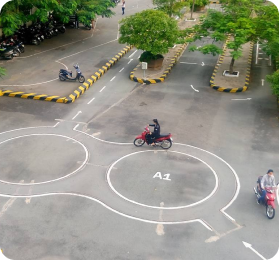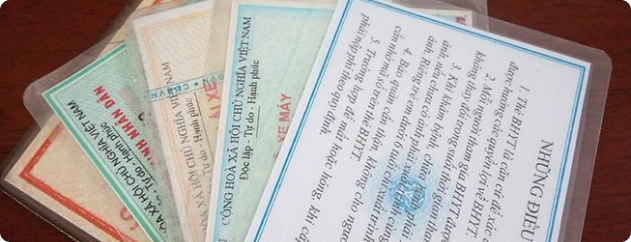A health check-up for obtaining or renewing a driver’s license is one of the mandatory procedures before participating in driving lessons, taking the driving test for all categories, or renewing a license. The health check-up process at SBB ensures speed, convenience, and legal compliance in accordance with regulations.
SBB Healthcare is a clinic licensed by the Department of Health to provide comprehensive health check-ups, including health check-ups for obtaining or renewing a driver’s license. It is also approved by the Department of Transportation to offer this service.




Driver’s Health Check-up
Service provided by SBB Health check-up to assess eligibility for issuing, renewing, or upgrading a driver’s license.
Notes for Driver’s Health Check-up
When attending a health check-up for a driver’s license, you need to bring:
• National ID card (personal identification for verification)
• 01 photo (3x4cm or 4x6cm) to attach to the application
• Accurately provide information on the application
• Follow the coordinator’s instructions during the check-up
INFORMATION
Excerpt from Appendix I, Joint Circular: 24/2015/TTLT - MOH/MOT
SPECIALTIES
Class A1 License
Class B1 License
Class A2, A3, A4, B2, C, D, E, FB2, FC, FD, FE License
Mental Health
• Currently experiencing acute mental disorders
• Chronic mental disorders with inability to control behavior
• Acute mental disorder that has been completely treated but not for a full 6 months
• Chronic mental disorder with inability to control behavio
• Acute mental disorder that has been completely treated but not for a full 24 months
• Chronic mental disorder
Neurology
• Paralysis of two or more limbs
• Paralysis of two or more limbs
• Extrapyramidal syndrome
• Deep sensory disorders
• Dizziness due to pathological causes
• Paralysis of one or more limbs
• Extrapyramidal syndrome
• Superficial or deep sensory disorders
• Dizziness due to pathological causes
Eye
• Distance vision in both eyes: < 4/10 (even with corrective lenses)
• If only one eye remains, vision < 4/10 (even with corrective lenses)
• Distance vision in both eyes: < 5/10 (even with corrective lenses)
• If only one eye remains, vision < 5/10 (even with corrective lenses)
• Distance vision in each eye: good eye < 8/10 or weak eye < 5/10 (even with corrective lenses)
• Refractive error with lens prescription: > +5 diopters or > -8 diopters
• Horizontal visual field in both eyes (nasal-temporal direction): < 160°, expanding to the right < 70°, expanding to the left < 70°
• Vertical visual field (up-down direction) above and below the horizontal line < 30°
• Hemianopia, peripheral scotoma • Disorders in recognizing the three basic colors: red, yellow, green
• Disorders in recognizing the three basic colors: red, yellow, green
• Disorders in recognizing the three basic colors: red, yellow, green
• Diplopia (double vision), even with prism correction
• Conditions causing light sensitivity
• Reduced vision at dusk (night blindness)
Ear - Nose - Throat
Hearing ability in the better ear:
• Normal speech < 4 meters (even with the use of a hearing aid);
• Or ability to hear whispered speech in the better ear £ 1.5 meters (even with the use of a hearing aid).
• Second-degree atrioventricular (AV) block or bradycardia accompanied by clinical symptoms (even if treated but not stable)
• Hypertension, where treatment results in a maximum systolic blood pressure ≥ 180 mmHg or diastolic blood pressure ≥ 100 mmHg
• Low blood pressure (systolic BP < 90 mmHg) accompanied by a history of symptoms such as dizziness, fatigue, drowsiness, or fainting
• Vascular inflammatory or obstructive diseases (arterial or venous) and vascular malformations with clinical manifestations affecting the ability to operate a motor vehicle
• Arrhythmias: supraventricular tachycardia, ventricular tachycardia, atrial flutter, atrial fibrillation, atrial tachycardia, and sinus tachycardia > 120 cycles/min, even if treated but not yet stabilized
• Ventricular ectopic beats in individuals with structural heart disease and/or classified as grade III or higher according to Lown’s classification
• Second-degree atrioventricular (AV) block or bradycardia with clinical symptoms (even if treated but not stabilized)
• Angina caused by coronary artery disease
• Heart failure of grade III or higher (according to the New York Heart Association – NYHA classification)
• Post-coronary revascularization intervention
• Heart failure of grade II or higher (according to the New York Heart Association – NYHA classification)
Respiratory
Diseases or conditions causing shortness of breath at grade III or higher (according to the mMRC classification).
• Diseases or conditions causing shortness of breath at grade II or higher (according to the mMRC classification)
• Partially controlled or uncontrolled bronchial asthma
• Infectious stage of pulmonary tuberculosis
Musculoskeletal
• Amputation or loss of function in one hand or one foot, with the remaining hand or foot also impaired (either amputated or with reduced function)
• Amputation or loss of function in one hand or one foot, with the other hand or foot being impaired (either amputated or with reduced function).
• Stiffness/ankylosis of a major joint
• Pseudarthrosis in one of the large bones
• Excessive spinal curvature (kyphosis, scoliosis) causing hyperlordosis; spinal stiffness/ankylosis affecting mobility
• Absolute length difference between two upper limbs or two lower limbs of 5 cm or more without support devices
Endocrinology
Diabetes with a history of diabetic coma within the past month.
Use of Medication, Alcohol, Drugs, and Psychoactive Substances
• Use of illicit drugs
• Use of alcohol at concentrations exceeding the specified limits
• Use of illicit drugs
• Use of alcohol at concentrations exceeding the specified limits
• Use of illicit drugs
• Use of alcohol at concentrations exceeding the specified limits
• Use of medications that affect alertness
• Abuse of stimulants (such as amphetamines, cocaine) and hallucinogenic substances
REVIEW